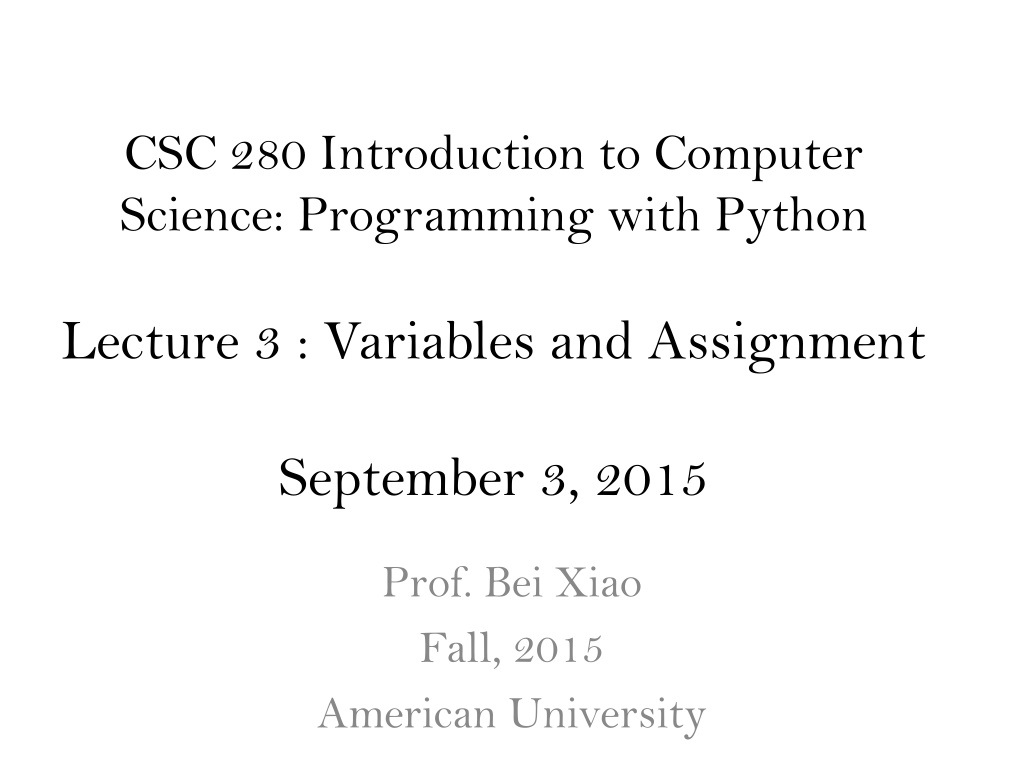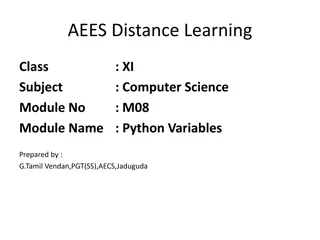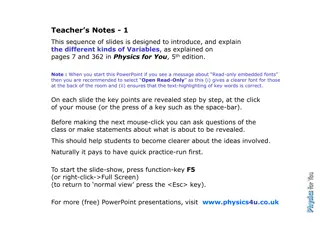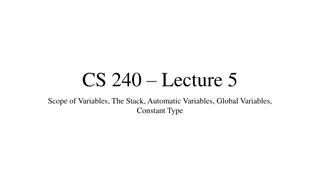Introduction to Variables and Assignment in Computer Science
This lecture covers the fundamentals of variables and assignment in computer science using Python. Explore the concepts of type conversion, operator precedence, and creating and utilizing variables in programming. Learn how to use the IDEL editor to write scripts for executing commands in Python.
Download Presentation

Please find below an Image/Link to download the presentation.
The content on the website is provided AS IS for your information and personal use only. It may not be sold, licensed, or shared on other websites without obtaining consent from the author. Download presentation by click this link. If you encounter any issues during the download, it is possible that the publisher has removed the file from their server.
E N D
Presentation Transcript
CSC 280 Introduction to Computer Science: Programming with Python Lecture 3 : Variables and Assignment September 3, 2015 Prof. Bei Xiao Fall, 2015 American University
Outline Type review Operator Precedence Variable Assignment Dynamic Typing
Review of type conversion What happens if you do >>> 'ab' + 3 How about: >>> 'ab' + str(3) >>> int('3') + 3 What happes if you do this? >>> int('0.0') How about >>> int(2.1)
Type: Set of values and the operation on them
Operator Precedence What is the difference between the following? 2* (1+3) 2*1 +3 Operations are performed in a set order Parentheses make the order explicit What happens when there are no parentheses? Operator Precedence: The fixed order of Python process operators in absence of parentheses? http://www.tutorialspoint.com/python/python_basic_opera tors.htm
Operator Precedence Precedence goes downwards Parentheses highest Logical ops lowest Same line = Same Precedence Read ties from left to right for all but (**) Example: 1 /2 * 3 = (1/2) *3 Exponentiation: ** Unary Operators: + - (e.g. 3- -2) Binary arithmetic: * / % Binary arithmetic: + - Comparison: <> <= >= Equality relations: == != Logical not Logical and Logical or See Section 2.7 in your textbook Will do more in Lab next week
Using IDEL editor to create a file Program = Script = Code Execute from the script A script is a sequence of commands Each one tells the interpreter to do something >>> print type(3)
Variables A Variable Is a named memory location (box) Contains a ( in the box) Can be used in expressions Examples:
Variables and Assignment Statements Variables are created by assignment statements Create a new variable name and give it a value x = 5 This is a statement, not an expression Tells the computer to DO something. Type into >>> get no response, but it is working Assignment statements can have expressions in them. These expressions can even have variables in them. the value the variable
Execute the statement: x = x+2 Draw variable x on piece of paper, x = 5. Use a box to represent the variable.
Execute the statement: x = x+2 Draw variable x on piece of paper, x = 5. Use a box to represent the variable. Step 1: evaluate the expression x+2 For x, use the value in variable x Write the expression somewhere on your paper Step 2: Store the value of the expression on x. Cross off the old value in the box Write the new value in the box Check to see whether you did the same thing as your neighbor.
Execute the statement: x = x+2 Draw variable x on piece of paper Step 1: evaluate the expression x+2 For x, use the value in variable x Write the expression somewhere on your paper Step 2: Store the value of the expression on x. Cross off the old value in the box Write the new value in the box Check to see whether you did the same thing as your neighbor.
Execute the statement: x = 3*x +1 You have this: Execute this command: Step 1: Evaluate the expression Step 2: Store its value in x Check to see whether you did the same thing as your neighbor, discuss it if you did something else.
Execute the statement: x = 3.*x +1 You have this: Execute this command: Step 1: Evaluate the expression Step 2: Store its value in x Check to see whether you did the same thing as your neighbor, discuss it if you did something else.
Exercise: Understanding Assignment Add another variable, interestRate, to get this: Execute this assignment: interstRate = 4 interestRate = x/intrestRate Can you draw the box for interestRate? What do you get?
Exercise: Understanding Assignment Add another variable, interestRate, to get this: Execute this assignment: interstRate = 4 interestRate = x/intrestRate Can you draw the box for interestRate? What do you get?
Exercise: Understanding Assignment Add another variable, interestRate, to get this: Execute this assignment: interstRate = 4 interestRate = x/intrestRate Can you draw the box for interestRate? What do you get?
Exercise: Understanding Assignment You now have this Execute this assignment: intrestRate = x+interestRate Can you draw the box for interestRate? What do you get?
Exercise: Understanding Assignment You now have this Execute this assignment: intrestRate = x+interestRate Can you draw the box for interestRate? What do you get?
A pause Do the following statement: X = 5 X +1 print X print X+1 What is the result?
Variables can be string Assignment statement myString = bei myString = myString + xiao print myString >>> myString = 'bei'; >>> myString 'bei' >>> myString = myString + 'xiao' >>> mySTring
Dynamic Typing Python is a dynamically typed language Variables can hold values of any type Variables can hold different types at different times. Use types(x) to find out the type of the value in x. Use names of types for comparison and conversion. The following is acceptable in Python: >>> x=1 x contains an int value >>> x = x/2.0 x now contains a float value. Alternative, is a statically typed language (e.g. Java) Each variable restricted to values of just one type
raw_input() raw_input expects integrator the user to type in a string. >>> y = raw_input('enter a number ?') enter a number ?35.7 What is the type of y? Raw_input() is different from input(), you should AVOID using input()
Exercise 1: using Python to calculate Suppose the cover price of a book is $24.95, but the bookstores get a 40% discount. Shipping costs $3 for the first copy and 75 cent for additional copy. Write a program to print the wholesale cost for 60 copies?
Exercise 2 Create a new file and name it as BMI.py Using raw_input() to ask the user of their height and weight, save these values as variables, and compute the body BMI and print out the result. Hint: BMI is a person s weight in kilograms divided by the square of height in meters. BMI = weight /(height**2) in meters/kg BMI = weight /(height**2) * 703 in lbs/inches 1lbs = 0.45kg 1inch = 0.025 meters Extra: how about when users actually enters in units of lbs and inches?
Exercise 3: print out basic info Enter your first name: Chuck Enter your last name: Norris Enter your date of birth: Month? March Day? 10 Year? 1940 Chuck Norris was born on March 10, 1940. Hint: how to print comma? print mo, day+ , year.
Take home reading Read Chapter 2 Do the following exercise: http://learnpythonthehardway.org/book/ex4. html Read about Operators in Python: http://www.tutorialspoint.com/python/pytho n_basic_operators.htm
Next week Monday, No class. Labor day. Wed, First lab sessions. Notice: missing two lab sessions will get you 0% in attendance.
























